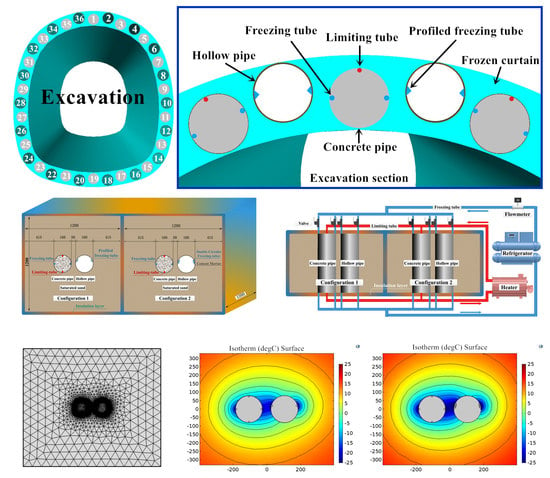Experimental and Numerical Investigation on Improved Design for Profiled Freezing-tube of FSPR
Abstract
:1. Introduction
2. Scaled Model Test and Process
2.1. Scaling Laws
2.2. Design of Model and Improvement of Profiled Freezing-tube
2.3. Design of Monitoring System
2.4. Test Process
3. Test results and Discussion
3.1. Vertical and Horizontal Measurement Points
3.2. Circumferential Points around The Hollow Pipe
4. Numerical Simulation and Discussion
4.1. Model Establishment and Verification of Test Results
4.2. Freezing Temperature Field Simulation Results Discussion
5. Conclusions
Author Contributions
Funding
Conflicts of Interest
Data Availability
References
- Cheng, H. Theory and Technology of Shaft Sinking by Freezing Method for Deep Alluvium, 1st ed.; Science Press: Beijing, China, 2016; pp. 118–120. (In Chinese) [Google Scholar]
- Cheng, H.; Yao, Z.S.; Zhang, J.S. A model test study on the effect of freeze heaving and thaw subsidence for tunnel construction with artificial horizontal ground freezing. China Civ. Eng. J. 2007, 40, 80–85. [Google Scholar] [CrossRef]
- Ma, W. Review and prospect of the studies of ground freezing technology in China. J. Glaciol. Geocryol. 2001, 23, 218–224. [Google Scholar] [CrossRef]
- Li, S.; Lai, Y.; Zhang, M.; Zhang, S. Minimum ground pre-freezing time before excavation of Guangzhou subway tunnel. Cold Reg. Sci. Technol. 2006, 46, 181–191. [Google Scholar] [CrossRef]
- Yang, Y.; Lai, Y.; Chang, X. Laboratory and theoretical investigations on the deformation and strength behaviors of artificial frozen soil. Cold Reg. Sci. Technol. 2010, 64, 39–45. [Google Scholar] [CrossRef]
- Cai, H.; Li, S.; Liang, Y.; Yao, Z.; Cheng, H. Model test and numerical simulation of frost heave during twin-tunnel construction using artificial ground-freezing technique. Comput. Geotech. 2019, 115, 103155. [Google Scholar] [CrossRef]
- Yao., Z.S.; Cai, H.B.; Cheng, H. The Model Test Study on Frost Heaving and Melting Sedimentation of Subway Tunnel Construction with Manual Level Freezing Method. Advanced Materials Research. 2011, 243, 3476–3483. [Google Scholar] [CrossRef]
- Afshani, A.; Akagi, H. Artificial ground freezing application in shield tunneling. Jpn. Geotech. Soc. Spéc. Publ. 2015, 3, 71–75. [Google Scholar] [CrossRef] [Green Version]
- Yan, Q.; Xu, Y.; Yang, W.-B.; Geng, P. Nonlinear Transient Analysis of Temperature Fields in an AGF Project used for a Cross-Passage Tunnel in the Suzhou Metro. KSCE J. Civ. Eng. 2018, 22, 1473–1483. [Google Scholar] [CrossRef]
- Ji, Y.; Zhou, G.; Zhou, Y.; Hall, M.R.; Zhao, X.; Mo, P.-Q. A separate-ice based solution for frost heaving-induced pressure during coupled thermal-hydro-mechanical processes in freezing soils. Cold Reg. Sci. Technol. 2018, 147, 22–33. [Google Scholar] [CrossRef]
- Lai, Y.; Zhang, S.; Yu, W. A new structure to control frost boiling and frost heave of embankments in cold regions. Cold Reg. Sci. Technol. 2012, 79, 53–66. [Google Scholar] [CrossRef]
- Zhou, J.; Tang, Y. Artificial ground freezing of fully saturated mucky clay: Thawing problem by centrifuge modeling. Cold Reg. Sci. Technol. 2015, 117, 1–11. [Google Scholar] [CrossRef]
- Zhu, H.H.; Yan, Z.G.; Li, X.Y.; Liu, X.Z.; Shen, G.P. Analysis of Construction Risks for Pipe-roofing Tunnel in Saturated Soft Soil. Chin. J. Rock Mech. Eng. 2005, 24, 5549–5554. [Google Scholar]
- Wang, X.; Dong, P.; Chen, S. Preparation of Macroporous Al2O3 by Template Method. Acta Physico Chimica Sin. 2006, 22, 831–835. [Google Scholar] [CrossRef]
- Brun, B.; Ha, H. Underground Line U5 ‘Unter Den Linden’ Berlin, Germany Structural and Thermal Fe-Calculations for Ground Freezing Design. In Proceedings of the International Conference on Numerical Simulation of Construction Processes in Geotechnical Engineering for Urban Environment, Bochum, Germany, 23–24 March 2006; pp. 225–232. [Google Scholar]
- Kamakura, T.; Aso, T.; Hamaguchi, K.; Inoue, H. Development of tunnel expansion method (SR-J) for underground highway junction. In Proceedings of the 60 Annual Conference of the Japan Society of Civil Engineers, Tokyo, Japan, 7–9 September 2005; Volume 6, pp. 165–166. [Google Scholar]
- Hamaguchi, K.; Yabe, Y.; Yoshitake, K. Development of small diameter shield combined large-section widening method (SR-JP). In Proceedings of the 61 Annual Conference of the Japan Society of Civil Engineers, Kusatsu, Japan, 20 September 2006; Volume 61, pp. 139–140. [Google Scholar]
- Ueda, Y.; Ohrai, T.; Yamamoto, M. Improvement of Bending Strength of Frozen Soil Beam Reinforced by Steel Pipe. Doboku Gakkai Ronbunshu 2001, 12, 81–90. [Google Scholar] [CrossRef] [Green Version]
- Pimentel, E.; Papakonstantinou, S.; Anagnostou, G. Numerical interpretation of temperature distributions from three ground freezing applications in urban tunnelling. Tunn. Undergr. Space Technol. 2012, 28, 57–69. [Google Scholar] [CrossRef]
- Pimentel, E.; Sres, A.; Anagnostou, G. Large-scale laboratory tests on artificial ground freezing under seepage-flow conditions. Géotechnique 2012, 62, 227–241. [Google Scholar] [CrossRef]
- Zhang, P.; Ma, B.; Zeng, C.; Xie, H.; Li, X.; Wang, D. Key techniques for the largest curved pipe jacking roof to date: A case study of Gongbei tunnel. Tunn. Undergr. Space Technol. 2016, 59, 134–145. [Google Scholar] [CrossRef]
- Hu, X.; She, S. Study of Freezing Scheme in Freeze-Sealing Pipe Roof Method Based on Numerical Simulation of Temperature Field. ICPTT 2013 2012, 1798–1805. [Google Scholar] [CrossRef]
- Hu, X.D.; Ren, H.; Chen, J.; Cheng, Y.; Zhang, J. Model test study of the active freezing scheme for the combined pipe-roof and freezing method. Mod. Tunn. Technol. 2014, 51, 92–98. [Google Scholar] [CrossRef]
- Hu, X.; Fang, T. Numerical Simulation of Temperature Field at the Active Freeze Period in Tunnel Construction Using Freeze-Sealing Pipe Roof Method. Soil Behav. Geomechanics 2014. [Google Scholar] [CrossRef]
- Hu, X.D.; Fang, T.; Guo, X.D.; Ren, H. Temperature field research on thawing process of Freeze-Sealing Pipe Roof Method in Gong-bei Tunnel by in-situ prototype test. J. China Coal Soc. 2017, 42, 1700–1705. [Google Scholar] [CrossRef]
- Ren, H.; Hu, X.D.; Chen, J.; Zhang, J. Study on Freezing Effect and Operation of Profiled Enhancing Freezing-tube in Freeze-sealing Pipe Roof. Tunn. Constr. 2015, 35, 1169–1175. [Google Scholar] [CrossRef]
- Kaasik, K.; Lee, C.C. Reciprocal regulation of haem biosynthesis and the circadian clock in mammals. Nature 2004, 430, 467–471. [Google Scholar] [CrossRef] [PubMed]
- Hu, J.; Hong, W.; Zeng, H.; Liu, Y.; Li, Y.P. Numerical analysis of temperature field of new pipe-roof freezing method. J. Railw. Sci. Eng. 2016, 13, 1165–1172. [Google Scholar] [CrossRef]
- Sun, J.-Y.; Tong, J. Fracture toughness properties of three different biomaterials measured by nanoindentation. J. Bionic Eng. 2007, 4, 11–17. [Google Scholar] [CrossRef]
- Cui, G.X.; Lu, Q.G. Study on law of thickness and deformation of ice-wall by using models. J. China Coal Soc. 1992, 17, 37–47. [Google Scholar] [CrossRef]
- Cui, G.X. The principle of model test for freezing shaft sinking. J. China Univ. Mining Technol. 1989, 18, 59–68. [Google Scholar]
- Zhang, Z.; Boyland, A.J.; Sahu, J.K.; Clarkson, W.A.; Ibsen, M. Single frequency Tm-doped fibre DBR laser at 1943 nm. In Proceedings of the CLEO/Europe—EQEC 2009—European Conference on Lasers and Electro-Optics and the European Quantum Electronics Conference, Munich, Germany, 14–19 June 2009; Volume 28, p. 1. [Google Scholar] [CrossRef] [Green Version]
- Taylor, R.N. Geotechnical Centrifuge Technology, 1st ed.; Blackie Academic & Professional: London, UK, 1994; pp. 273–280. [Google Scholar]
- Cai, H.B.; Cheng, H.; Yao, Z.S.; Wang, H. Numerical analysis of ground displacement due to orthotropic frost heave of frozen soil in freezing period of tunnel. Chin. J. Rock Mechan. Eng. 2015, 34, 1667–1676. [Google Scholar] [CrossRef]
- Yuanming, L.; Songyu, L.; Ziwang, W.; Wenbing, Y. Approximate analytical solution for temperature fields in cold regions circular tunnels. Cold Reg. Sci. Technol. 2002, 34, 43–49. [Google Scholar] [CrossRef]
- Hu, X.-D.; Fang, T.; Han, Y.-G. Mathematical solution of steady-state temperature field of circular frozen wall by single-circle-piped freezing. Cold Reg. Sci. Technol. 2018, 148, 96–103. [Google Scholar] [CrossRef]
- COMSOL Multiphysics Reference Manual. 2018. Available online: https://doc.comsol.com/5.4/doc/com.comsol.help.comsol/COMSOL_ReferenceManual.pdf (accessed on 15 August 2020).


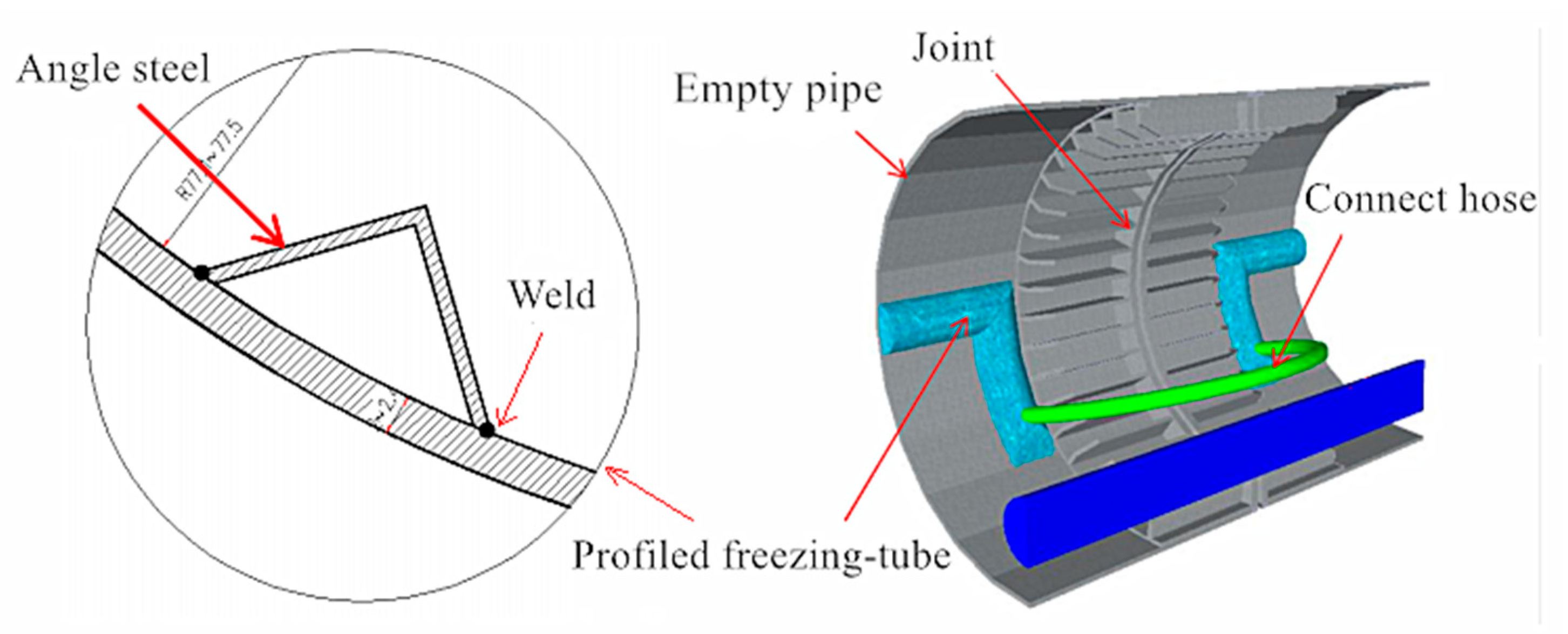
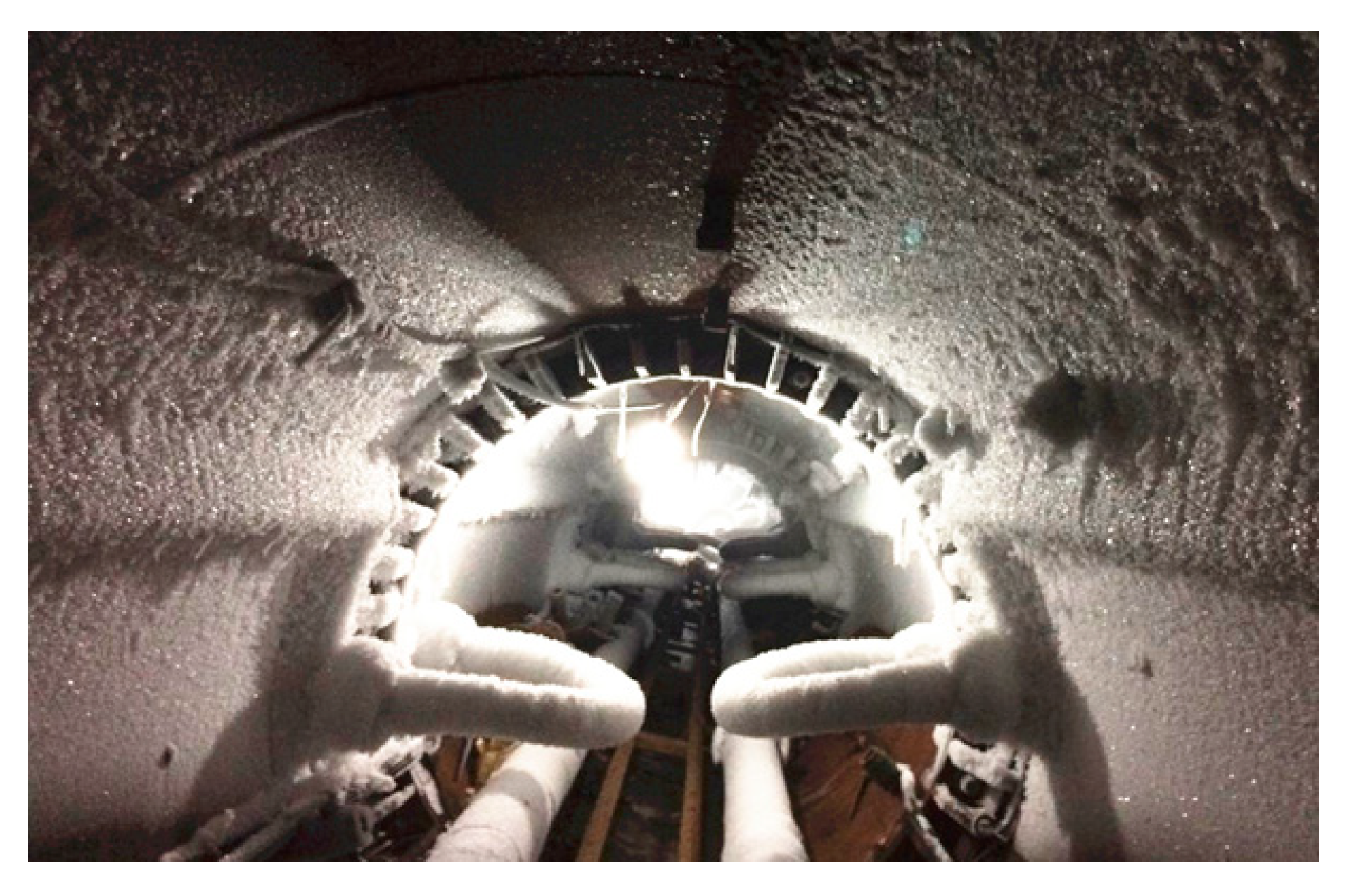


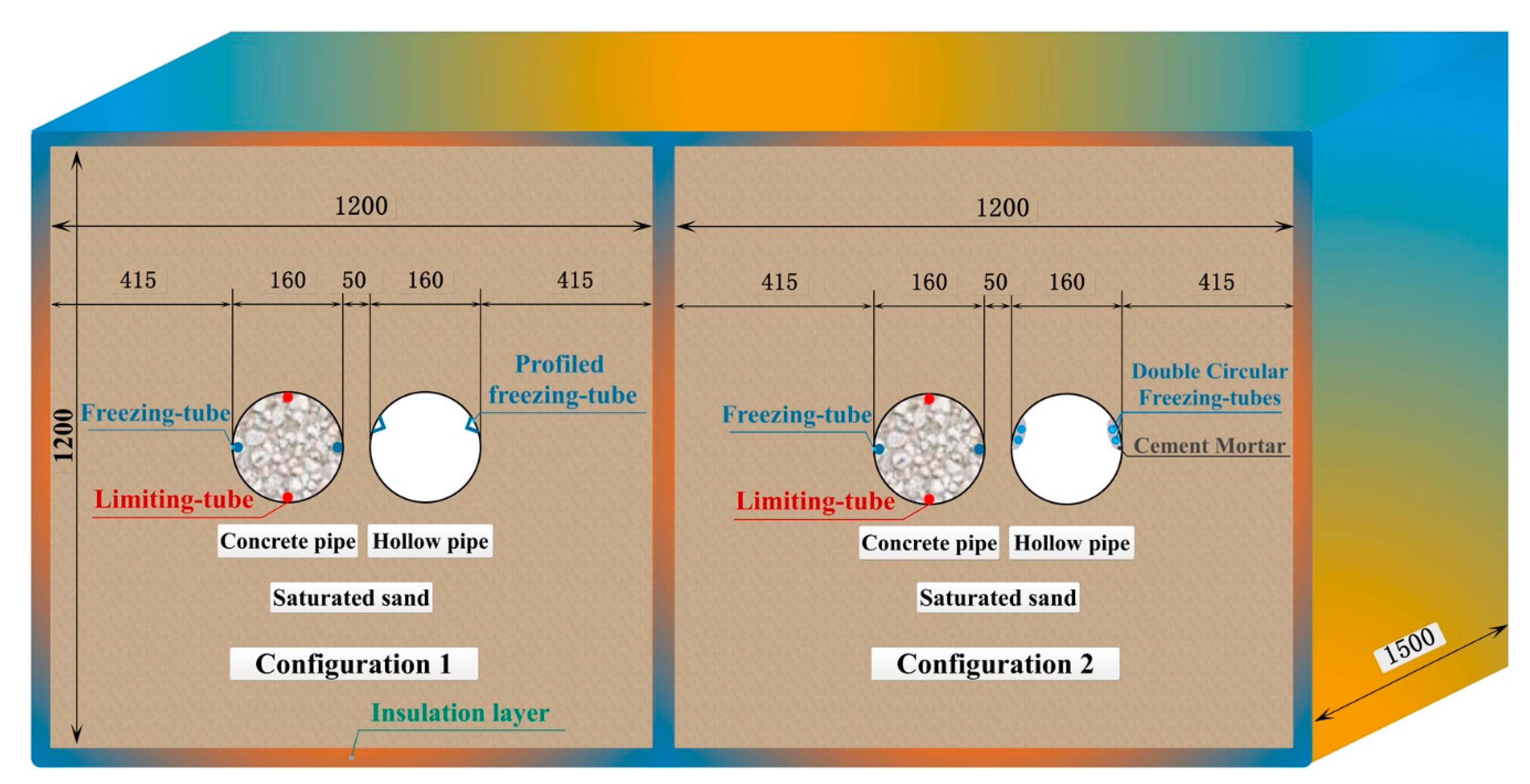


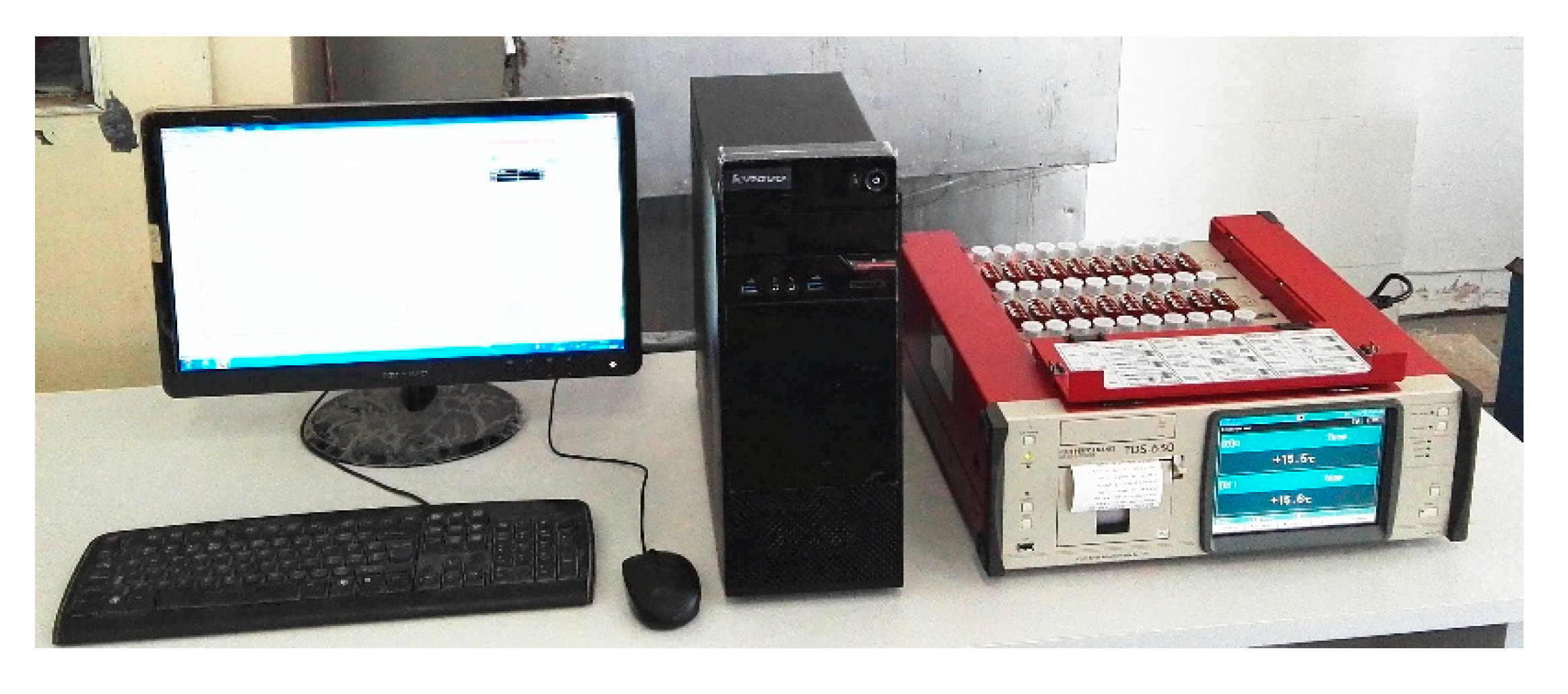

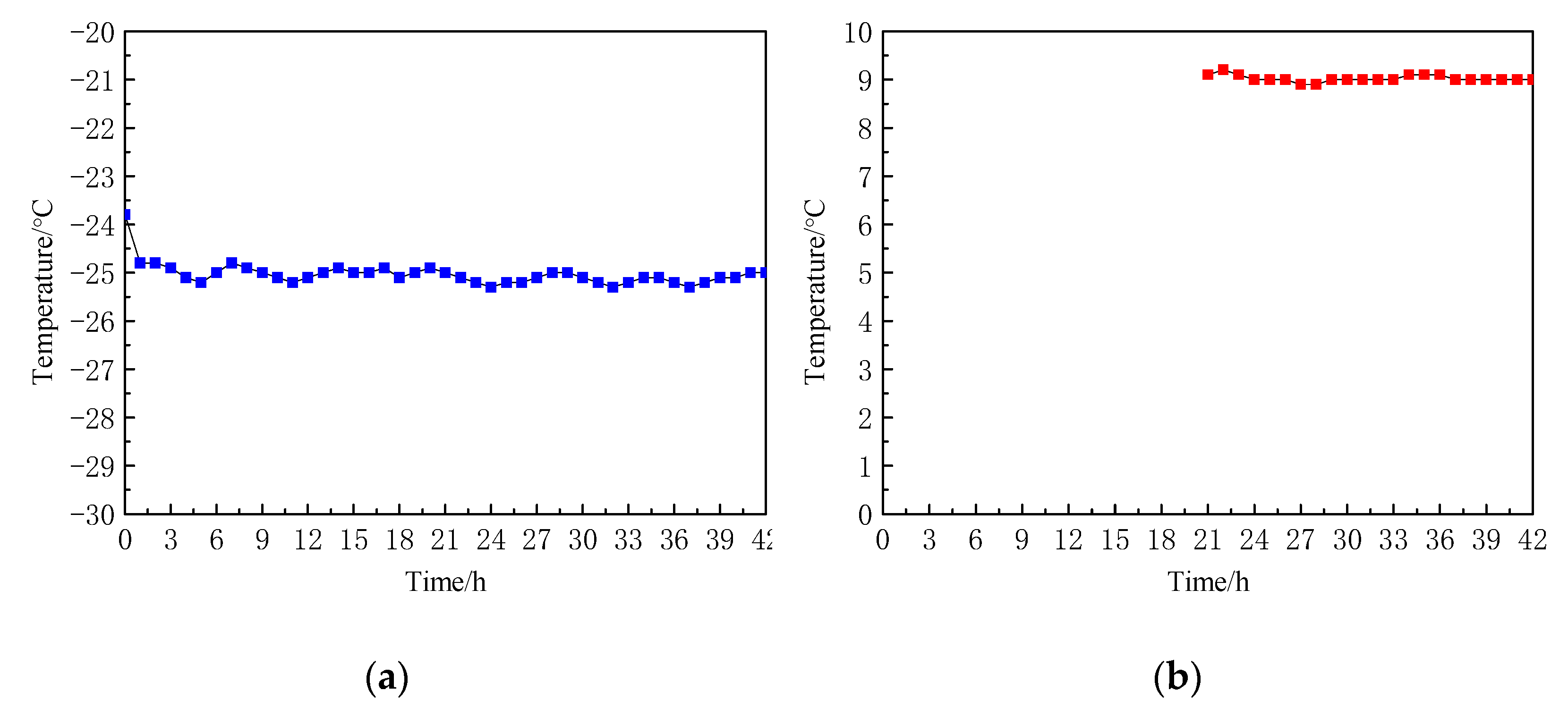
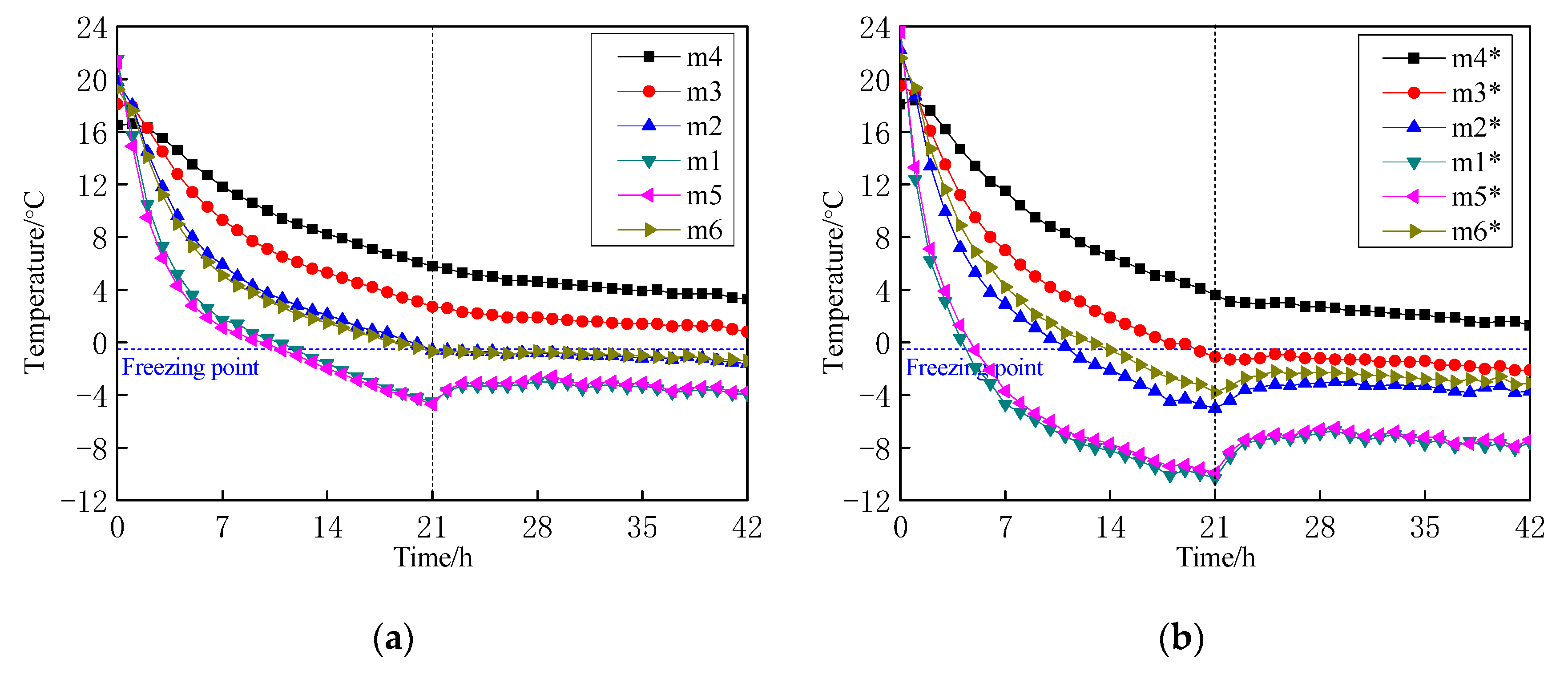
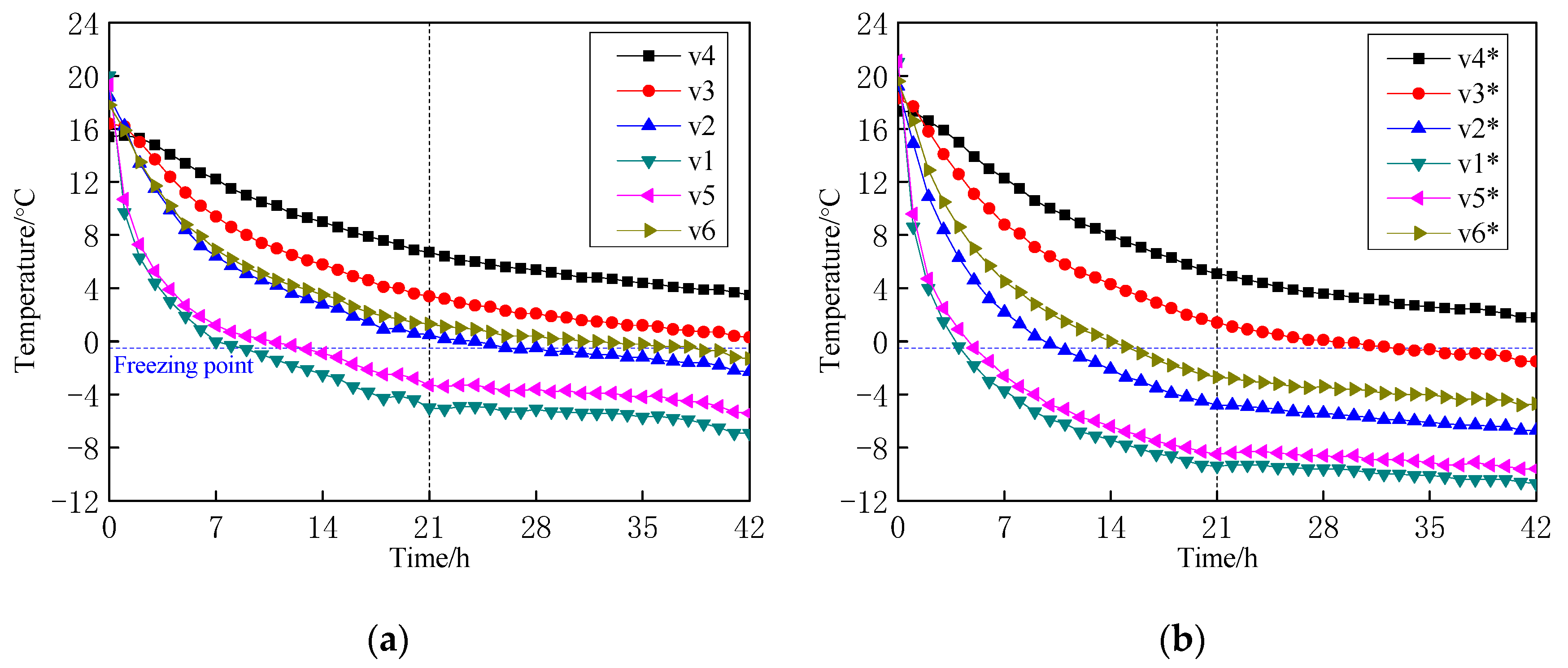
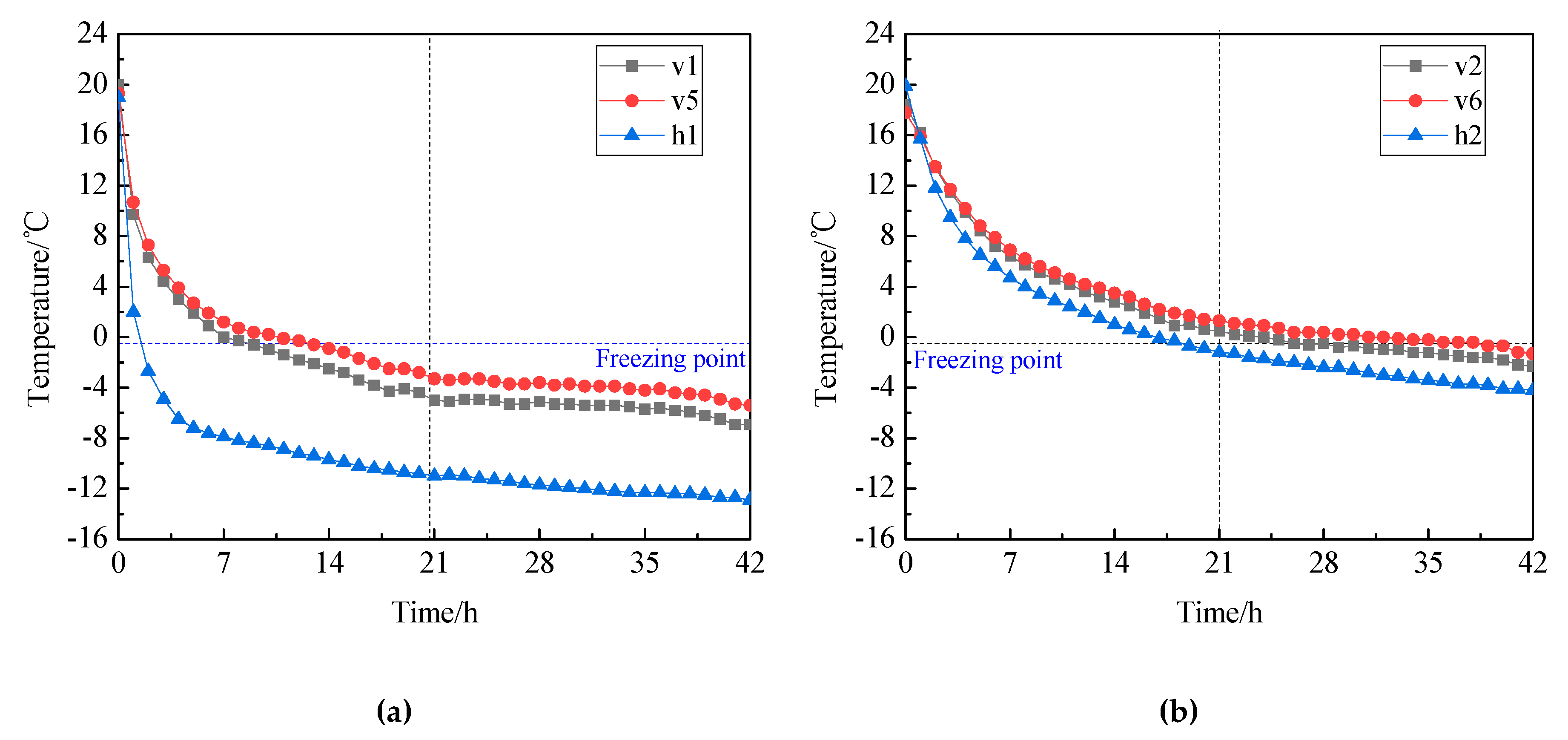
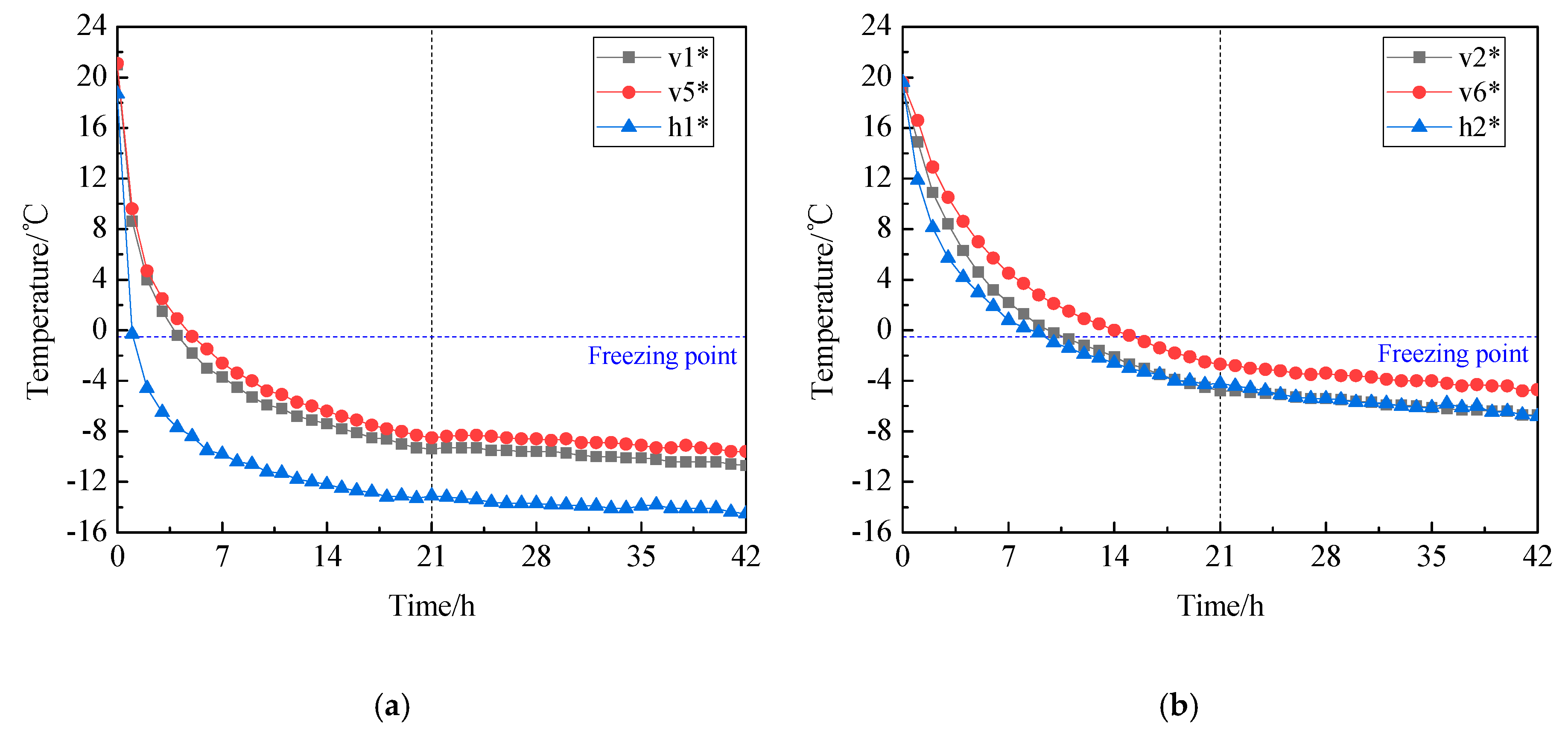

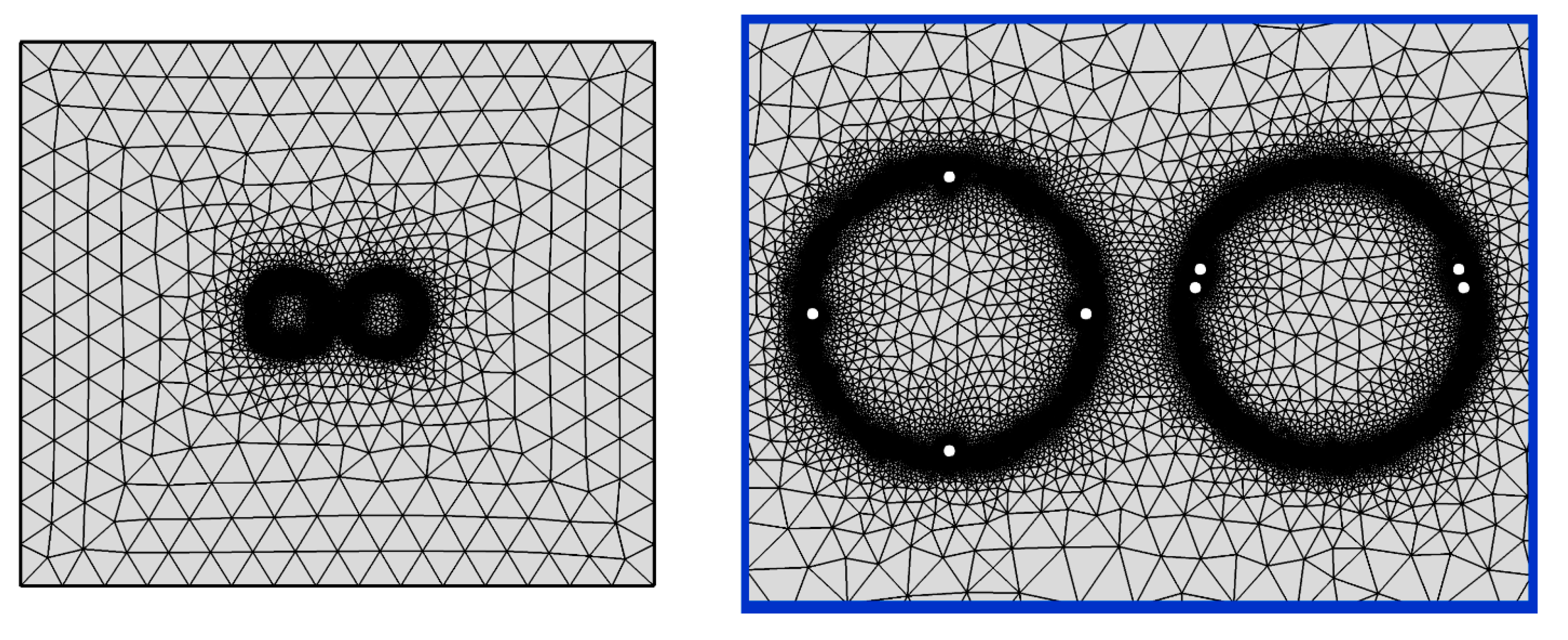
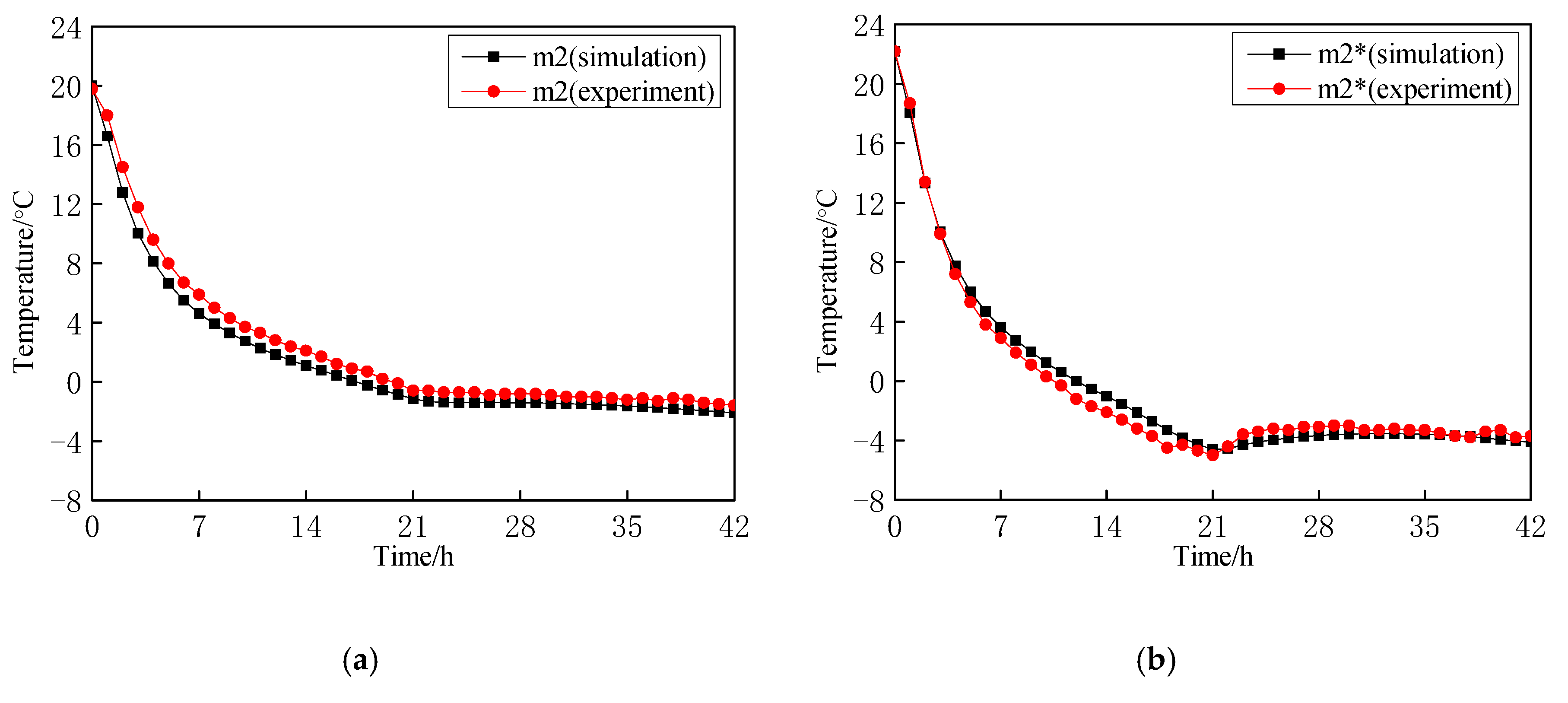
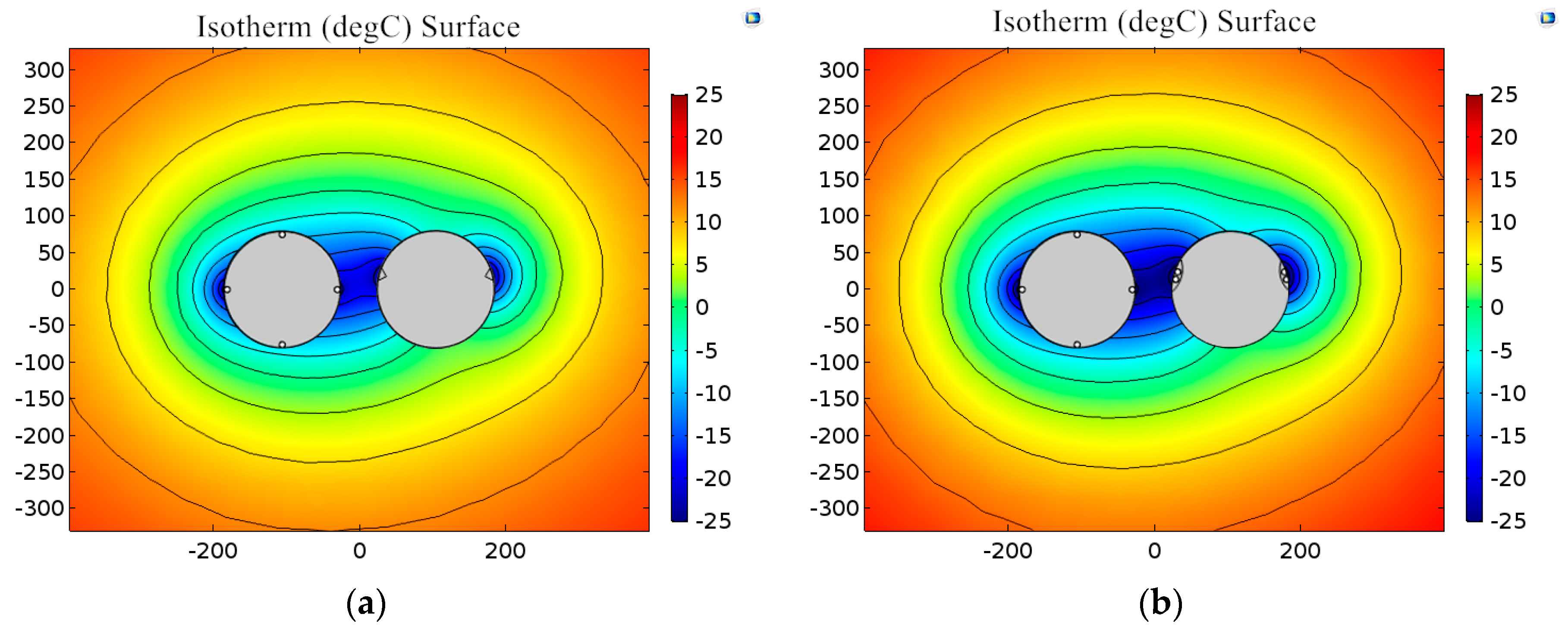
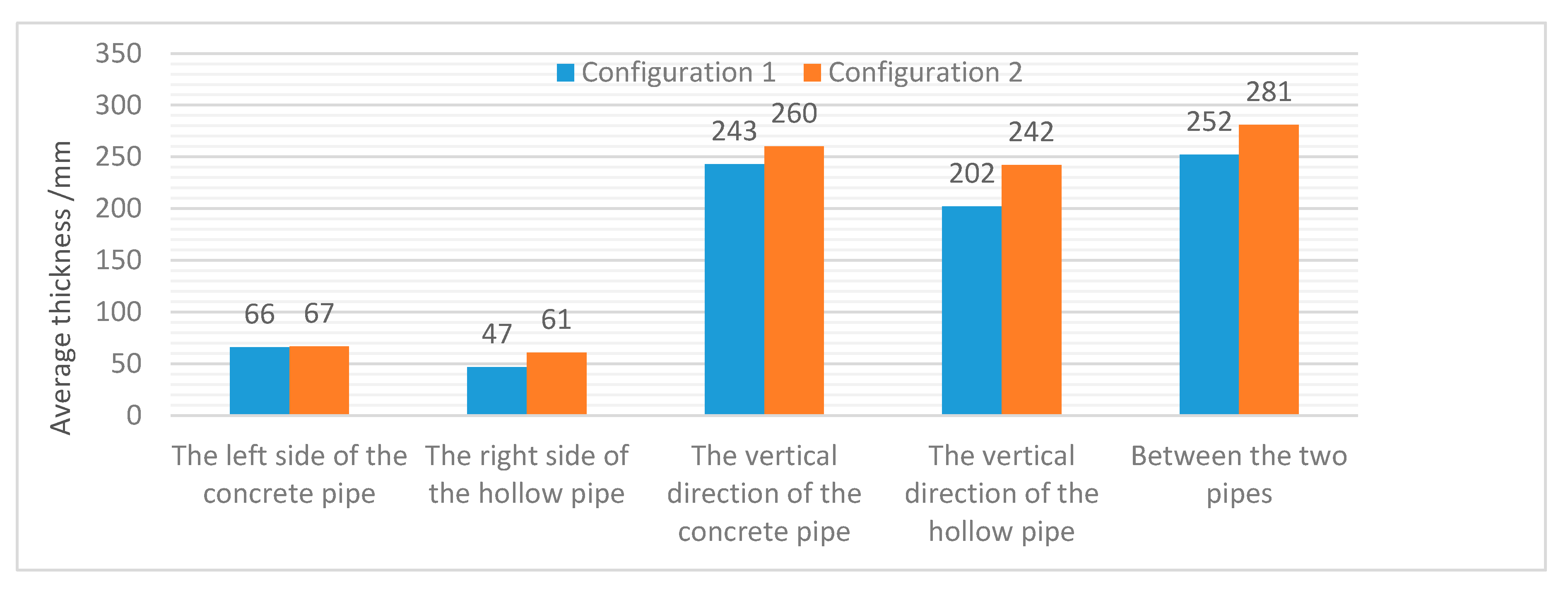
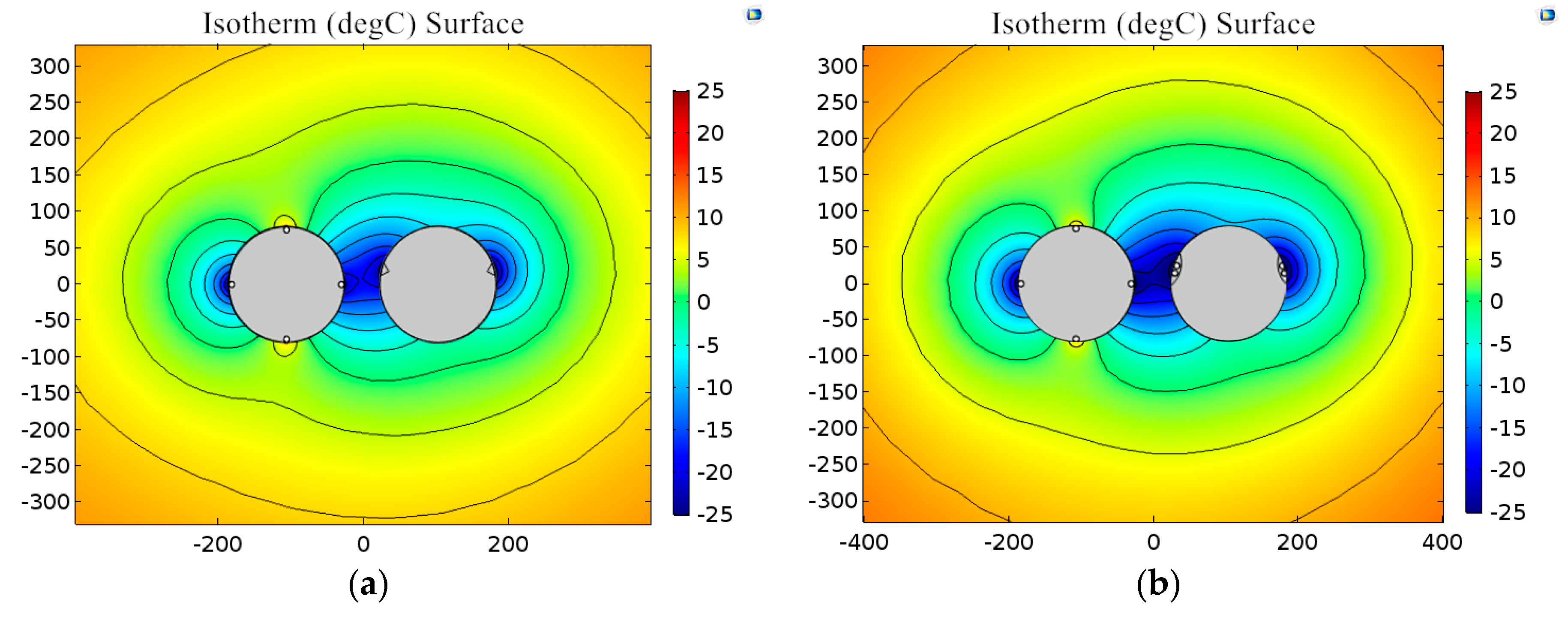
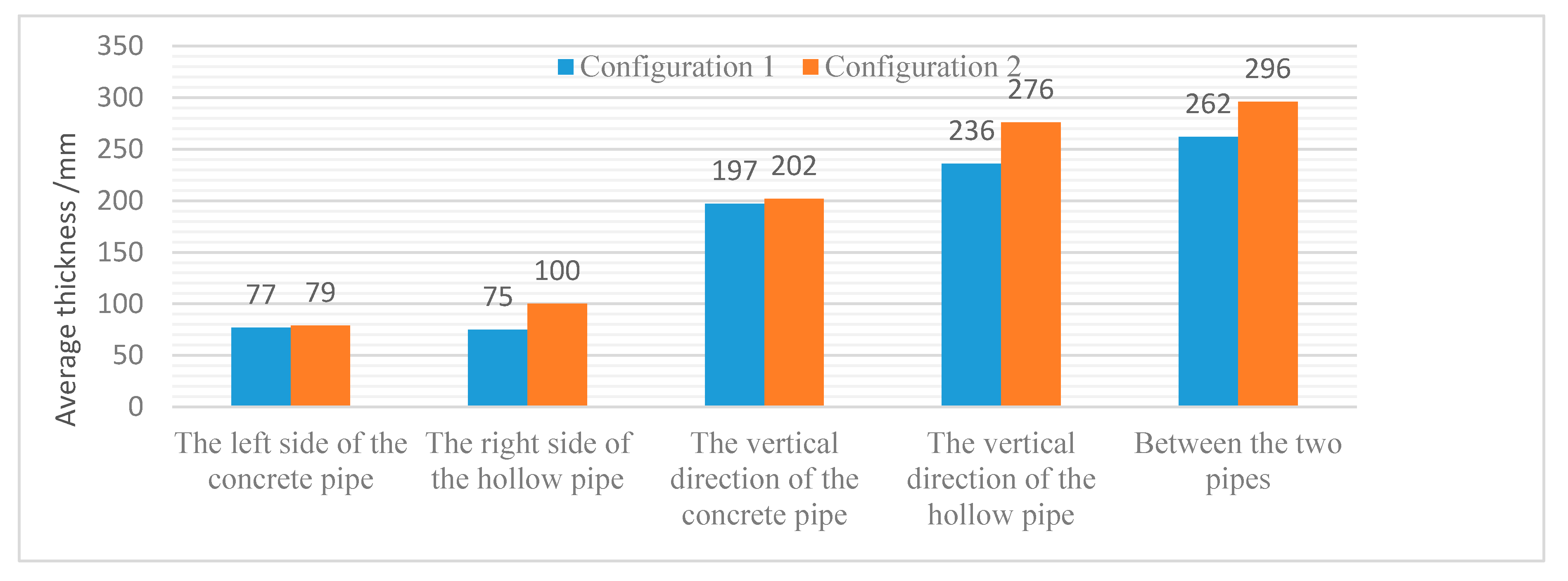
| Components | Prototype Dimension (mm) | Model Dimension (mm) |
|---|---|---|
| Concrete pipe & hollow pipe (Diameter) | 1600 | 160 |
| Main freezing-tube (Diameter) | 80 | 8 |
| Profiled freezing-tube (Equilateral angle steel) | 125125 | 12.512.5 |
| Limiting-tube (Diameter) | 80 | 8 |
| Parameter | Prototype Velocity Parameter (Single Tube) | Model Velocity Parameter (Single Tube) |
|---|---|---|
| Tube diameter (mm) | 80 | 8 |
| Rate of flow (m3/h) | 5 | 0.5 |
| Velocity of flow (m/min) | 16.58 | 165.8 |
| Test Soil | Saturated Moisture (%) | Density (g·cm−3) | Thermal Capacity (kJ·kg−1·°C−1) | Thermal Conductivity (W·m−1·K−1) | Freezing Temperature (°C) | |
|---|---|---|---|---|---|---|
| ρ | ρd | |||||
| Saturated sand | 40.29 | 1.435 | 1.317 | 1.372 | 1.475 | −0.5 |
| Testing Time | Environment Average Temperature (°C) | Average Temperature of Saltwater in Freezing Tube (°C) | Average Temperature of hot Saltwater in Limiting-Tube (°C) | Initial Average Temperature of the Soil (°C) | ||
|---|---|---|---|---|---|---|
| Centerline of the Pipes | Vertical Axis of the Hollow Pipe | Horizontal Axis of the Hollow Pipe | ||||
| 3:30 pm, Apr.30 | 26 | −25 | 9 | 20.2 | 18.7 | 18.4 |
| Measurement Point | t21 (°C) |
Δt21 (°C) | t42 (°C) |
Δt24 (°C) | V1 (°C/h) | V2 (°C/h) | Time of Temperature Below Freezing Point (h) | Δh (h) |
|---|---|---|---|---|---|---|---|---|
| m2 | −0.6 | −4.4 | −1.6 | −2.1 | −0.97 | −0.05 | 21 | −9 |
| m2* | −5 | −3.7 | −1.30 | 0.06 | 12 | |||
| m6 | −0.7 | −3.1 | −1.4 | −1.7 | −1.03 | −0.03 | 21 | −7 |
| m6* | −3.8 | −3.1 | −1.21 | 0.03 | 14 |
| Measurement Point | t21 (°C) |
Δt21 (°C) | t42 (°C) |
Δt24 (°C) | V1 (°C/h) | V2 (°C/h) | Time of Temperature Below Freezing Point (h) | Δh (h) |
|---|---|---|---|---|---|---|---|---|
| v2 | 0.5 | −5.3 | −2.3 | −4.4 | −0.85 | −0.13 | 26 | −14 |
| v2* | −4.8 | −6.7 | −1.14 | −0.09 | 12 | |||
| v6 | 1.3 | −4.0 | −1.3 | −3.4 | −0.79 | −0.12 | 33 | −17 |
| v6* | −2.7 | −4.7 | −1.06 | −0.10 | 16 |
| Measurement Point | t21 (°C) |
Δt21 (°C) | t42 (°C) |
Δt24 (°C) | V1 (°C/h) | V2 (°C/h) | Time of Temperature Below Freezing Point (h) | Δh (h) |
|---|---|---|---|---|---|---|---|---|
| h2 | −1.2 | −3 | −4.2 | −2.6 | −1.00 | −0.14 | 19 | −9 |
| h2* | −4.2 | −6.8 | −1.13 | −0.12 | 10 | |||
| h3 | 4.7 | −3.4 | 0.7 | −2.9 | −0.7 | −0.19 | — | — |
| h3* | 1.3 | −2.2 | −0.97 | −0.16 | 30 |
| Materials | Density (kg·m-3) | Thermal Capacity (J·kg-1·K) | Thermal Conductivity (W·m-1·K-1) | Freezing Point (°C) | |||
|---|---|---|---|---|---|---|---|
| Soil | ρ | ρsat | unfrozen | frozen | unfrozen | frozen | −0.5 |
| 1435 | 2055.1 | 1372 | 1071 | 1.475 | 1.795 | ||
| Concrete | 2450 | 920 | 1.95 | - | |||
| Steel pipe | 7850 | 318 | 60 | - | |||
| Cement mortar | 1900 | 840 | 1.28 | - | |||
| Air | 1.29 | 1005 | 0.02 | - | |||
© 2020 by the authors. Licensee MDPI, Basel, Switzerland. This article is an open access article distributed under the terms and conditions of the Creative Commons Attribution (CC BY) license (http://creativecommons.org/licenses/by/4.0/).
Share and Cite
Duan, Y.; Rong, C.; Cheng, H.; Cai, H.; Wang, Z.; Yao, Z. Experimental and Numerical Investigation on Improved Design for Profiled Freezing-tube of FSPR. Processes 2020, 8, 992. https://doi.org/10.3390/pr8080992
Duan Y, Rong C, Cheng H, Cai H, Wang Z, Yao Z. Experimental and Numerical Investigation on Improved Design for Profiled Freezing-tube of FSPR. Processes. 2020; 8(8):992. https://doi.org/10.3390/pr8080992
Chicago/Turabian StyleDuan, Yin, Chuanxin Rong, Hua Cheng, Haibing Cai, Zongjin Wang, and Zhishu Yao. 2020. "Experimental and Numerical Investigation on Improved Design for Profiled Freezing-tube of FSPR" Processes 8, no. 8: 992. https://doi.org/10.3390/pr8080992




